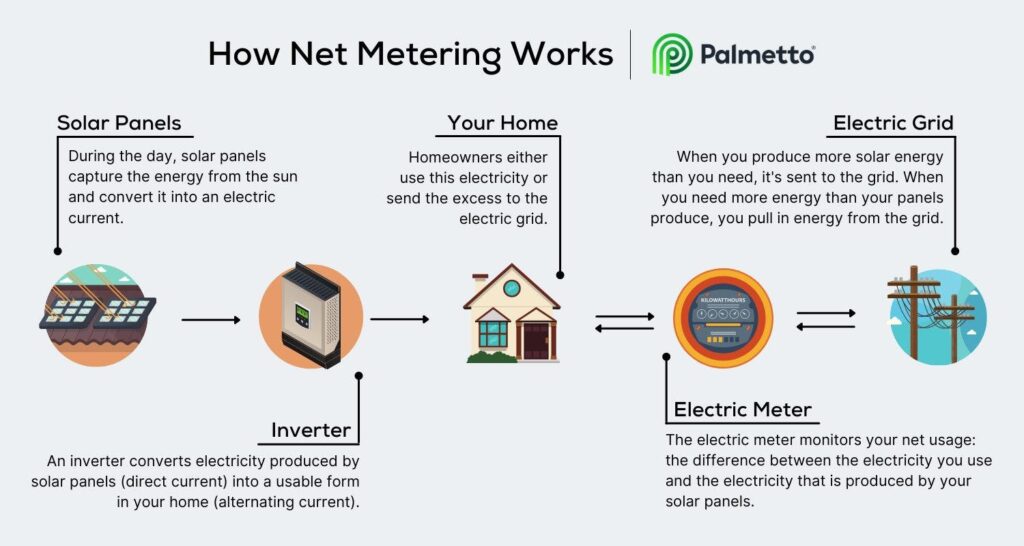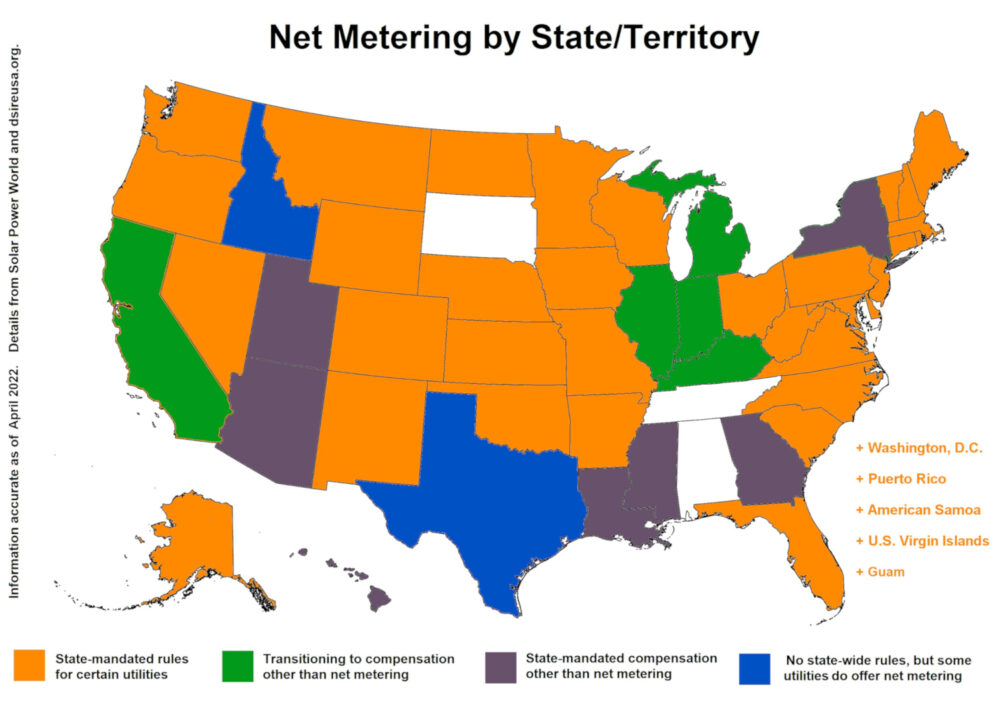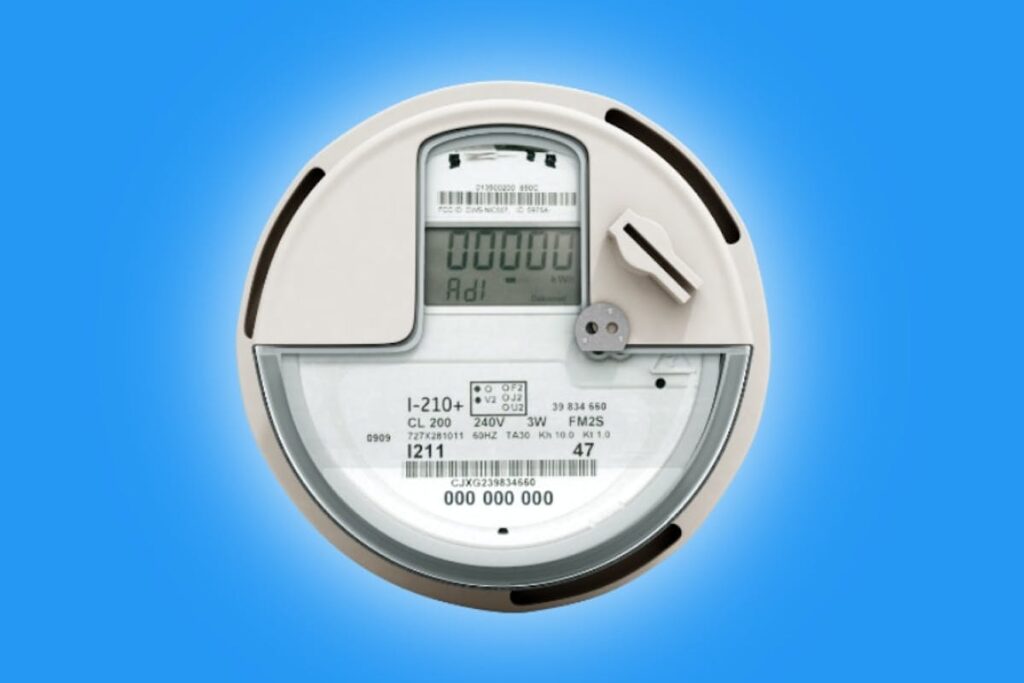Ever wondered about the ins and outs of net metering? Dive into this all-inclusive guide, and we’ll break down everything about net metering and why it’s advantageous.
Net metering is a billing system that lets homes and businesses produce green energy and send surplus electricity back to the grid. Think of it like your electricity meter running in reverse, decreasing your monthly charges, or even granting you credits. It’s a beneficial arrangement for the user and our planet.
In this piece, we’ll touch on the core principles of net metering, discuss its implementation across various regions, and shine a light on its pros and cons. We’ll also tackle frequently asked topics such as who can apply, the setup procedure, and net metering’s effect on the broader grid.
Whether you’re considering getting solar panels for your residence or have a keen interest in eco-friendly energy alternatives, grasping net metering is essential. So, let’s jump in and unravel the intriguing realm of net metering.
What is net metering?
Net metering is a billing method where people and businesses can balance out their power usage by producing their own green energy, using resources like solar panels or wind turbines. If these installations generate more power than what’s consumed on-site, the extra energy goes back into the grid, essentially making the electric meter run in reverse.
This system is supported with a two-way meter, often called a net meter. It’s designed to track the electricity flow in both incoming and outgoing directions. It notes the gap between the power drawn from the grid and the energy created by the green setups. This setup lets users gain credits for the surplus power they produce, which they can later use to decrease their power bills.
Beyond just being an advantage for individual users, net metering is a boon for the larger power grid. By channeling spare energy back, it lessens the need for electricity from conventional power stations. This results in lower carbon footprints and paves the way for a greener energy landscape.
How does net metering work?
Imagine a homeowner who has solar panels fixed on their roof. In daylight, with the sun out, these panels produce electricity. This power caters to the homeowner’s needs first. If there’s still some power left over after fulfilling the home’s requirements, that surplus is directed back to the grid, and the homeowner receives bill credits.
However, during nighttime, or when the panels aren’t generating power, the home will rely on the grid for its energy needs. The credits accumulated from the day’s excess generation then come into play, offsetting the cost of the power taken from the grid. This ensures that homeowners are billed only for the net amount of electricity they consume, giving rise to the term “net metering.”
Worth noting that net metering generally rolls over on a monthly cycle, but the cycle may vary in different areas. This means any extra credits garnered in a month can be used in subsequent months, often up to a set duration like a year.

Credit: palmetto.com
Net metering vs. traditional metering
To truly grasp the advantages of net metering, it’s helpful to juxtapose it against the conventional metering system, which is the prevalent way of gauging and billing power consumption.
With conventional metering, you’re billed for the entirety of the electricity you pull from the grid, even if you’re generating some power independently at your location. So, even if you have renewable sources, like solar panels, you’d still lean on the grid when your renewables aren’t supplying all the power you need.
Conversely, net metering offers a chance for consumers to balance out their grid consumption with the electricity they generate themselves. Surplus power? It goes back to the grid, decreasing your bill or adding credits to your account. This setup encourages more people to embrace renewable energy sources and minimizes dependence on conventional power stations.
Another pivotal distinction lies in how you’re billed. Under conventional metering, your bill reflects the total electricity you’ve taken from the grid during your billing cycle, which is typically monthly. Net metering introduces a twist: you’re billed on the net amount of electricity used. This considers any surplus power you’ve returned to the grid. So, you’re paying for only the electricity you’ve drawn from the grid after deducting what you’ve produced and shared back.
What are the benefits of net metering
Net metering brings a host of benefits to users and the environment. Here are some of its standout positives:
- Savings on Bills: By creating their own power and balancing their usage through net metering, users can noticeably trim their electricity costs. Some may even amass credits that can be applied to future bills.
- Boosting Green Energy: Net metering gives a stronger incentive to adopt green energy systems like solar panels or wind turbines. Investing in renewable sources becomes financially more appealing with the chance to balance consumption and gain credits.
- Eco-friendly: By tapping into renewables, net metering decreases dependence on traditional power plants running on fossil fuels. This reduces carbon emissions, steering us towards a greener energy landscape.
- Strengthening the Grid: Net metering can also bolster the resilience of our electricity grid. Returning surplus energy ensures a more even distribution, especially during high-demand times, reducing grid stress and enhancing its consistency.
- Job Opportunities: As more people take up renewable energy and net metering grows, jobs in the green energy domain, from production and setup to upkeep and repair, are also on the rise.
While these advantages are typically tied to net metering globally, it’s essential to understand that the exact perks might differ based on local net metering guidelines and regulations.
Net metering regulations and policies
The way net metering is carried out differs broadly, depending on the country or even within specific states or provinces. These diverse regulations and guidelines influence the cost-effectiveness and appeal of setting up green energy systems.
In certain areas, laws make net metering compulsory, obligating utility providers to extend net metering provisions to qualifying consumers. Such regulations might set out specific criteria related to system dimensions, the kind of green energy sources used, and technical prerequisites. Moreover, they might stipulate the protocol for linking the green energy setup with the central grid and managing surplus power generation compensation.
Conversely, it becomes an optional practice in places with no legal obligation for net metering. Utility companies can choose to roll out net metering programs based on their internal strategies and considerations. Given this variability, the availability and conditions of net metering schemes can be quite diverse. Hence, users need to do their homework, familiarizing themselves with the rules and guidelines in their locale.

Credit: solarpowerworldonline.com
Is net metering available in your area?
Net metering programs are not universally available and might differ based on the country, region, or your local utility provider. If you’re curious about its availability in your location, a good starting point is to contact your local power company or explore the rules and guidelines surrounding net metering in your state or country.
Sometimes, there are specific criteria or restrictions to qualify for net metering. Such stipulations might relate to the size of your system, the maximum power it can generate, or particular technical standards it should meet. Grasping these specifications is vital to ensure your green energy system qualifies for net metering.
It’s also crucial to grasp the monetary side of net metering. This encompasses how much you’ll get paid for any surplus power and the duration for which you can retain these credits. These elements can differ based on the specific net metering scheme you’re looking at.
If you’re located in a region where net metering is an option, and you’re keen on leveraging it, here’s a step-by-step guide to kickstart your journey:
- Research: Dive deep into the net metering rules and guidelines specific to your locale. Pin down the prerequisites, permissible system dimensions, and any technical benchmarks.
- Analyze Your Power Consumption: Gauge your current electricity intake to decide the capacity of the renewable energy system you’d require. Think about aspects like your energy aspirations, the expanse of rooftop or ground space at your disposal, and your financial constraints.
- Select a Trustworthy Installer: Hunt for seasoned installers with valid certifications. They should be adept at crafting and setting up a renewable power system compliant with your region’s net metering standards. Solicit multiple estimates and weigh them against each other to ensure you get a bang for your buck.
- Apply for interconnection: Reach out to your neighborhood utility service. Navigate through their protocol to tie your renewable apparatus to the primary grid. This typically entails filing paperwork, sharing technical details, and covering requisite charges.
- Install and monitor your system: Post installation, keep tabs on how your system fares. It’s pivotal to ascertain that it’s churning out the anticipated electric output. Scrutinize your electric statements to discern the net metering’s effect on your monthly costs.
- Comprehend the Billing Mechanism: Acquaint yourself with your locality’s net metering billing dynamics. Grasp the methodology behind surplus credit evaluation, the span for which they remain valid, and their utilization against future invoices.
Armed with these guidelines and staying updated on the evolving net metering norms in your vicinity, you’ll be in a prime position to tap into its perks and optimize the returns from producing your electricity.

Credit: palmetto.com
Common misconceptions about net metering
Net metering has not been immune to misconceptions and skepticism despite its advantages. Let’s dissect some of the prevailing myths and set the record straight:
- Subsidization Myth: A common notion is that net metering customers get financial support from those who don’t. However, research indicates that the collective benefits of net metering, like cutting down on conventional power sources and slashing carbon footprints, counterbalance any probable costs.
- The Cost-Shifting Debate: Some believe those enjoying net metering are inadvertently hiking up the cost of grid upkeep for others. This isn’t entirely accurate. Those with net metering still lean on the grid when their green systems aren’t at peak output. Plus, the perks, like a steadier grid and minimized energy transmission loss linked with net metering, can counterbalance the minor surcharges.
- Concerns Over Grid Reliability: Detractors often highlight concerns about grid stability, especially during high renewable energy output. Yet, the research underscores that with adept grid oversight and foresight, folding in renewables via net metering can actually bolster the grid’s dependability and robustness.
- Inequity Arguments: A circulating myth suggests that net metering is a luxury reserved for well-off homeowners who can foot the bill for renewable setups. This isn’t the full picture. With thoughtful structuring, net metering initiatives can cater to a diverse demographic, embracing not just affluent homes but also economically challenged families and community-driven entities.
In discussions about net metering, it’s pivotal to lean on well-researched data and robust studies rather than baseless beliefs. The pros of net metering, spanning from monetary savings to the push for greener energy and a more robust grid, affirm its essential role in steering us toward a sustainable energy future.
To sum up
Harnessing the sun’s power is no longer just about green living; it’s a smart financial move, too. At the heart of this transition is “Net Metering”—a game-changing arrangement allowing homeowners to reap maximum benefits from their solar installations. By sending excess power back to the grid, you’re producing energy and potentially earning from it. Research underpins its advantages, from reducing conventional power reliance to enhancing grid stability. Dive deep, debunk the myths, and you’ll see net metering isn’t just a policy—it’s a powerful pivot towards a brighter, sustainable future. Make the switch, shine a light on savings, and contribute to a cleaner planet. Net metering is the future, and the future looks radiant.








